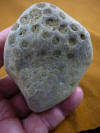|
PETOSKEY STONES
THE ROCK THAT'S ACTUALLY A FOSSIL!

(Fossil coral, Hexagonaria percarinata)
The soft living tissue of the corallite was called polyp. At the center of the polyp was the food intake opening or mouth. This dark spot, or the eye of the corallite, has been filled with silt or mud that petrified after falling into the openings. Surrounding the opening were tentacles that were used to gather food and draw the food into the mouth. The living corallite thrived on plankton which lived in the warm sea. The Petoskey stone is also known as a colony coral.
A Petoskey stone is a rock and a fossil, often pebble-shaped, that is composed of a fossilized rugose coral, Hexagonaria percarinata. Such stones were formed as a result of glaciation, in which sheets of ice plucked stones from the bedrock, grinding off their rough edges and depositing them in the northwestern (and some in the northeastern) portion of Michigan's lower peninsula. In those same areas of Michigan, complete fossilized coral colony heads can be found in the source rocks for the Petoskey stones. Petoskey stones are found in the Gravel Point Formation of the Traverse Group. They are fragments of a coral reef that was originally deposited during the Devonian period.
This is fossil coral, with a beautiful honeycomb pattern, fairly soft at Mohs 3 on the hardness scale. Michigan's State Rock. Antrim County MI holds a Petoskey Festival each year. Formed when Michigan was covered by a sea in which coral reefs thrived, the coral gradually became buried by sediment, which turned into limestone and shale. The skeletons were replaced by calcite (calcium, carbon & oxygen).
During the Ice Ages, from 1.6 million to 10,000 years ago, glaciers scraping over Michigan broke up soft, fossil-bearing rocks. The pieces were carried along and dropped, now found along lake beaches, road cuts, and gravel pits as rounded stones from pebble size to potato-sized lumps. Dated to 350 million years old (Devonian period). Found on the shores of Little Traverse Bay from the northwestern tip of the Lower Peninsula, especially around Petoskey and Charlevoix, Michigan.
The name "Petoskey" comes from an Ottawa Indian chief. When he was born, sunbeams fell upon his face so he was named Pe-tos-e-gay ("rising sun"). European settlers Anglicized the name as Petoskey.
|



_small.jpg)
_small.jpg)
_small.jpg)
_small.jpg)
_small.jpg)
_small.jpg)
_small.jpg)
_small.jpg)
_small.jpg)
_small.jpg)
_small.jpg)
_small.jpg)
_small.jpg)
_small.jpg)
_small.jpg)
_small.jpg)
_small.jpg)
_small.jpg)
_small.jpg)
_small.jpg)
_small.jpg)
_small.jpg)
_small.jpg)
_small.jpg)
_small.jpg)
_small.jpg)
_small.jpg)
_small.jpg)
_small.jpg)
_small.jpg)
_small.jpg)
_small.jpg)
_small.jpg)
_small.jpg)
_small.jpg)
_small.jpg)
_small.jpg)
_small.jpg)
_small.jpg)
_small.jpg)
_small.jpg)
_small.jpg)
_small.jpg)
_small.jpg)
















.JPG)
.JPG)







.JPG)
.JPG)
.JPG)
.JPG)
.JPG)
.JPG)
.JPG)
.JPG)
.JPG)
.JPG)









.JPG)
.JPG)
.JPG)
.JPG)
.JPG)
.JPG)
.JPG)
.JPG)
.JPG)
.JPG)
.JPG)
.JPG)





